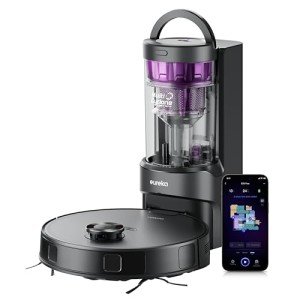The Evolution of Robot Hoovers: Revolutionizing Home Cleaning
Robot hoovers, likewise called robotic vacuum cleaners, have actually transformed how individuals approach home cleaning tasks. At first introduced in the late 1990s, these autonomous devices have developed rapidly due to improvements in technology, synthetic intelligence, and maker learning. Today, they are geared up with a range of functions that make them extremely effective in keeping tidiness in living areas. This post checks out the history, working, advantages, and future of robot hoovers.
The History of Robot Hoovers
The idea of robotic vacuums go back to the 1970s, however it wasn't up until the launch of the Roomba by iRobot in 2002 that they got mainstream attention. The Roomba was designed to immediately navigate different surfaces, preventing challenges while effectively cleaning floorings. Given that then, numerous significant advancements have happened, including:
| Year | Advancement |
|---|---|
| 1996 | Very first model robotic vacuum developed by a Japanese company. |
| 2002 | iRobot launches the Roomba, mass popularizing robotic vacuums. |
| 2004 | Intro of the very first Roomba with a dirt detection sensing unit. |
| 2011 | Release of designs with wireless capabilities and smart device integration. |
| 2020 | Advanced designs including AI, improved navigation systems, and mopping capabilities. |
How Robot Hoovers Work
Robot hoovers operate on a mix of sensors, cams, and algorithms that allow them to clean effectively. Secret components of these gadgets include:
Sensors:
- Obstacle Avoidance Sensors: Detect walls, furnishings, and even stairs, avoiding collisions and falls.
- Dirt Detection Sensors: Identify areas that require more thorough cleaning.
Navigation:
- Gyroscopes: Help determine the robot's orientation and movement.
- Video cameras and Lidar: Enable mapping of the home environment to produce optimum cleaning courses.
Cleaning Mechanisms:
- Vacuum Motors: Generate suction to choose up dirt and particles.
- Brush Rollers: Agitate dirt out of carpets for much deeper cleaning.
Power Supply:
- Batteries: Rechargeable lithium-ion batteries offer the needed power for extended cleaning cycles.
User Interface:
- Mobile Apps and Smart Home Integration: Users can arrange cleansings, display performance, and control the robot from another location.
Advantages of Robot Hoovers
Robot hoovers use numerous advantages, making them an appealing choice for modern-day families:
- Time-Saving: Automated cleaning allows users to focus on other jobs while the robot effectively cleans floors.
- Convenience: Many designs can be arranged for cleaning sessions, guaranteeing that homes stay tidy without manual effort.
- Accessibility: Ideal for people with movement difficulties or hectic way of lives, enabling much easier home maintenance.
- Consistent Cleaning: Regular, automated cleanings decrease the build-up of dirt and allergens, contributing to a healthier living environment.
- Smart Technology: Integration with smart home systems enables increased control and modification.
Limitations of Robot Hoovers
Despite their benefits, robot hoovers feature specific restrictions:
- Navigation Challenges: They may struggle in chaotic spaces or with certain floor types such as high-pile carpets.
- Battery Life: Most designs require routine charging, which can limit cleaning duration.
- Maintenance: Regular cleaning of filters, brushes, and emptying dust bins is required for optimum performance.
- Price: Advanced models can be costly compared to standard vacuum cleaners.
The Future of Robot Hoovers
As innovation continues to progress, the future of robot hoovers looks promising. Anticipated advancements include:
- Improved AI: Enhanced algorithms will permit better object acknowledgment and vibrant mapping of spaces.
- Hybrid Models: Integration of vacuuming and mopping capabilities in one gadget will provide a comprehensive cleaning solution.
- Increased Autonomy: Future models may navigate even the most intricate environments without human intervention.
- Sustainability: Battery technology improvements will lead to longer-lasting, more energy-efficient robots.
Often Asked Questions (FAQs)
1. Are robot hoovers efficient for pet hair removal?
Yes, numerous robot hoovers are particularly designed to deal with animal hair with powerful suction and specialized brushes that lower tangling.
2. How do click homepage navigate around furniture?
Robot hoovers use a combination of sensors and electronic cameras to detect obstacles, permitting them to browse around furniture and avoid collisions.
3. Can robot hoovers tidy carpets?
Many modern robot hoovers work on both hard floorings and carpets. It is advisable to examine the requirements of specific models for specific efficiency.
4. Do robot hoovers need shows?
Numerous robot hoovers include easy to use apps that allow owners to set schedules and personalize cleaning preferences, making programs simple.
5. How much do robot hoovers cost?
Prices for robot hoovers differ widely, ranging from ₤ 200 to around ₤ 1,500, depending on functions and brand.
Robot hoovers have come a long way given that their beginning, using an efficient and practical cleaning solution for modern-day households. Their increasing capability and intelligence make them a practical choice for individuals looking to streamline their cleaning regimens. As innovation continues to advance, robot hoovers will likely become much more capable, supplying extra functions that accommodate the developing requirements of users. Their journey from novelty to requirement highlights a basic shift in how society approaches home maintenance, marking a considerable milestone in the crossway of technology and every day life.

